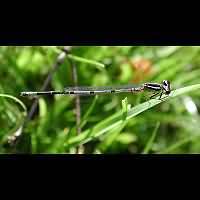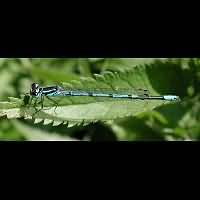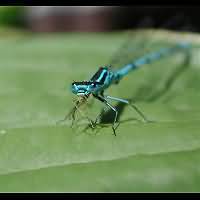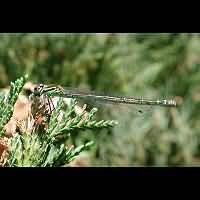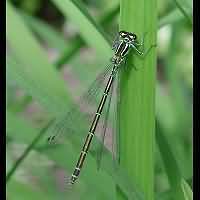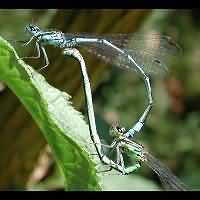[All pictures of garden wildlife on this page are thumbnails. Click on any thumbnail for a large format to be displayed.]
Azure Damselfly (Coenagrion puella)
The Azure Damselfly belongs to a group of similar blue Damselflies. Telling these blue species apart may be quite tricky. In males the marking on the second segment of the abdomen usually is sufficient. Each blue Damselfly is uniquely marked on that particular segment. In Azure Damselflies we see a blue U-shaped marking. Males are very blue, for only one segment is entirely black on top. This makes them the blueist of all Damselflies. Females however are black on top of all segments. This makes them the darkest of all female blue Damselflies. The females usually are greenish, rarely blueish or whitish. The thorax in both sexes has one, uninterrupted light line, which is slightly thinner than the black line underneath. Reaching a length of 30 to 35mm and a wingspan of 40 to 50mm this is one of the biggest blue Damselflies.
Like in all Dragonflies mating takes place by making a heart-shaped tandem, as can be seen in the bottom picture. Males cling to females by taking them behind the head. After mating males keep being attached to the females, which hangs off the male helplessly. In this way the eggs are being laid. The males usually stand straight on top of the egg-depositing female. Only when there is a lot of wind, males may grab on to a plant. The eggs are being deposited on plants growing just beneath the surface. After hatching the larvae will first live among the plants, later they move to the bottom. The entire cycle of life is completed in just one year.
The Azure Damselfly is found in almost all standing water. This may be a big lake, but a small pond in a garden will do as well. The water shouldn't be too acid though. The species thus is scarce in layer peat and forest lakes. The Azure Damselfly is one of the most common Damselflies in Britain, except for the northern parts of Scotland. It is on the wing from May to August.
Like in all Dragonflies mating takes place by making a heart-shaped tandem, as can be seen in the bottom picture. Males cling to females by taking them behind the head. After mating males keep being attached to the females, which hangs off the male helplessly. In this way the eggs are being laid. The males usually stand straight on top of the egg-depositing female. Only when there is a lot of wind, males may grab on to a plant. The eggs are being deposited on plants growing just beneath the surface. After hatching the larvae will first live among the plants, later they move to the bottom. The entire cycle of life is completed in just one year.
The Azure Damselfly is found in almost all standing water. This may be a big lake, but a small pond in a garden will do as well. The water shouldn't be too acid though. The species thus is scarce in layer peat and forest lakes. The Azure Damselfly is one of the most common Damselflies in Britain, except for the northern parts of Scotland. It is on the wing from May to August.

© Copyright 1998-2024 gardensafari.net (Hania Berdys)

 English / engels
English / engels  Dutch / nederlands
Dutch / nederlands